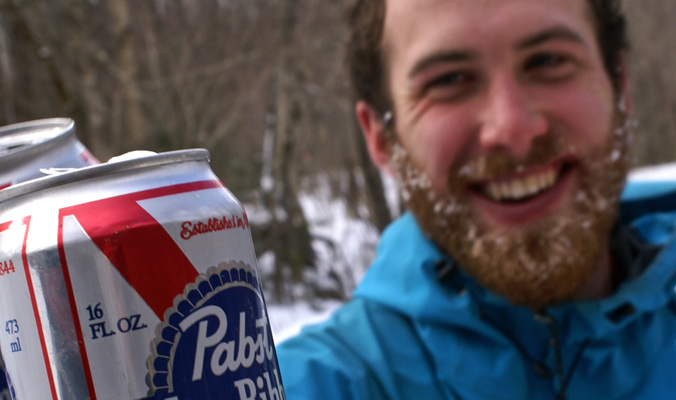I know a lot of guides who manage to ski all day and only drink a half-liter of tea. They also tend to have their first kidney stones around the age of 40. Fun! Conversely, when I toured with Greg Hill in Chile a few years back, I was surprised to learn that he would carry three liters of water for the day. And he managed to ski two-million vertical feet that year. More fun!
Since then, I’ve operated under the theory that staying hydrated greatly improves the odds of success. Here’s why and what to do.
We lose fluids through perspiration (sweating) and respiration (breathing). While ski touring, high elevation and drier air make this even more dramatic. And during the spring, warm weather further exaggerates the amount of fluid lost. Dehydration leads to a drop of performance—in stages from slowing down to bonking to needing medical attention.

Hydration is important before, during and après skiing.
Understanding Your Sweat Rate
Some people sweat a lot. Others, not so much. While there are several reasons for this, the more important thing is knowing how much you sweat at different exertion levels.
Figuring this out is easy—you only need a bathroom scale. Before a period of exercise, weigh yourself while fully hydrated. Then, keep track of the amount of fluid you drink during exercise and weigh yourself afterward.
Water weighs 2lbs. per quart (or one kilo per liter), so if you exercised for four hours, drank a full Nalgene bottle (one liter) and weigh two pounds less afterward, you lost about a half-liter per hour. If you lose about three-percent of your body weight during exercise, you’re going to feel like you’ve run out of gas, which you basically have.
I am relatively lightweight (<150lbs.) and also pretty efficient while touring. And when I am going at an easy pace, I have to drink 8 to 12 ounces per hour. While moving more quickly, I drink 16 to 24 ounces per hour. And if I’m going at “race pace” (which I try to avoid), I could easily drink 32 ounces in an hour. Multiply this over a six-to-eight-hour day and that’s a lot of liquid.
Use It Or Lose It
When you sweat, you lose water and electrolytes (salts), which are needed for the body to communicate between systems. And while each individual has his or her own balance of electrolytes, everyone has to replace these while exercising.
If you only replace the water lost through sweating, your body determines that you have too much water in the solution and gets rid of it as urine, which only adds to dehydration.
Instead of drinking straight water, find an exercise drink mix that works for you. Using a powder allows you to experiment with the amount of salt needed per liter of water, and it also allows you to find the simplest ingredient list possible. Remember, you don’t need natural flavors, dyes or preservatives—you need the electrolytes so your body’s systems keep talking to one another.
Hydration Games
Three or four liters of water is a lot of weight—between 6.6 and 8.8 lbs. Here are a few ways to lighten the load.
- Pre-hydrate. Try to drink a half liter or more of electrolyte mix right before exercise.
- Fill a bottle with hot water and a heavy dose of electrolytes. Then add snow to that bottle each time you drink from it.
- If you’re going to do laps, stash some of your drink at the bottom.
- If you’re going for a really long day, it might weigh less to bring a JetBoil-type stove and melt snow for water throughout the day.
It’s no coincidence that most accidents and bad decisions are made at the end of the day when we are exhausted. A lot of this can be avoided by staying properly hydrated.
Know how much water and salt you lose while exercising at different intensity levels. Then work to make sure you never lose more than three percent of your body weight while exercising—you’ll be ready for another lap, be happier on the way back to the car, make better decisions at the end of the day and be psyched for the next day.
—
Donny Roth is an AMGA-certified ski guide and professional skier. He writes about his adventures at independent-descents.com. Learn more about skiing with him in Chile at chile-powder-adventures.com.
This post was originally published in April 2016.










Hey Donny,
It sounds like you’ve got your body’s hydration game under control but there is danger in pushing the hydrate hydrate hydrate mantra . Because of this I wanted to leave some info about hyponatremia that you may be unaware of. Hyponatremia is the excess drinking of water to a point where there is an imbalance of salts in your body which you did mention. This imbalance leads to signs and symptoms very similar to dehydration but can be more dangerous if not caught.
With my time in the field as a guide what I would of typically thought of as dehydration with a client has more routinely been hyponatremia after being educated about it. It did lead me to wonder how much water we are suppose to drink but in essence there are to many variables and everybody is different. The one thing we can rely on is that when are body tells us we are thirsty is to drink some water.
Here are a few links to check out if you are curious.
http://www.maximumfun.org/adam-ruins-everything/adam-ruins-everything-episode-8-hydration-and-hyponatremia-tamara-hew-butler
http://www.diabetesincontrol.com/the-dangers-of-hyponatremia-better-dehydrated-than-overhydrated-during-exercise/
http://www.nejm.org/doi/full/10.1056/nejm200005253422107
People generally blame poor performance on factors other than the obvious one. I “blew up” because I didn’t eat enough or because I didn’t drink, but normally it was because they are simply unfit.
Drink when you’re thirsty. That is fail-safe.